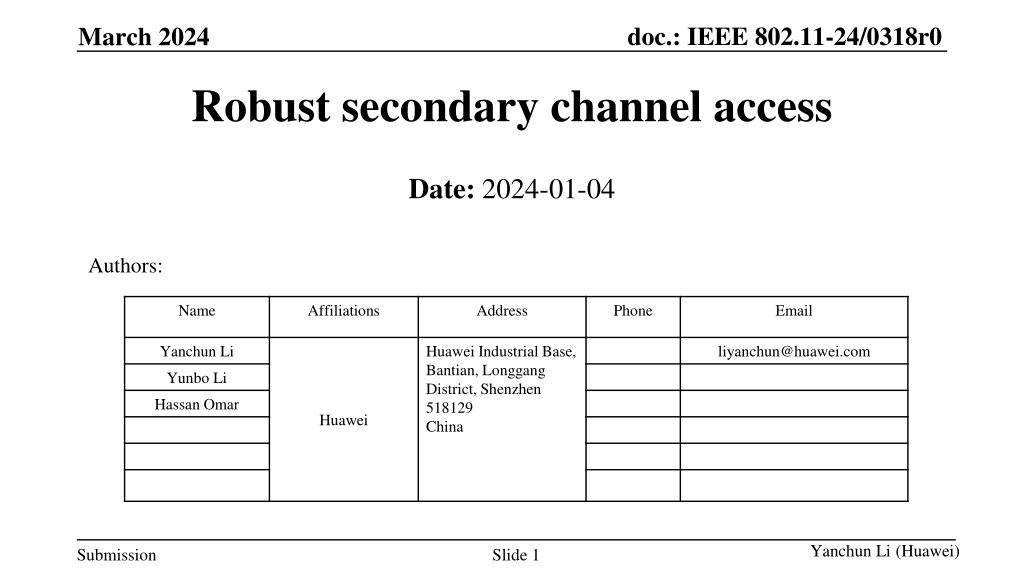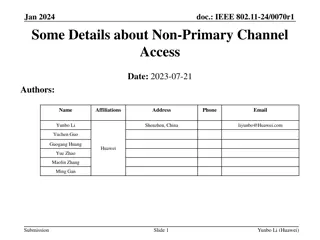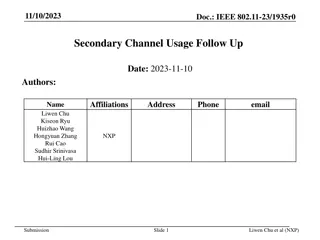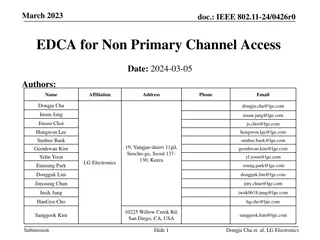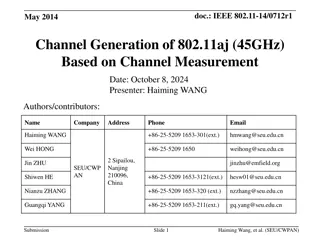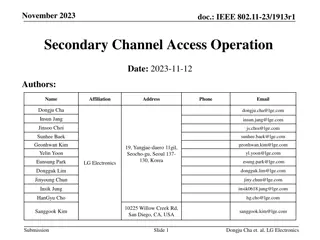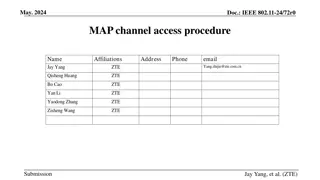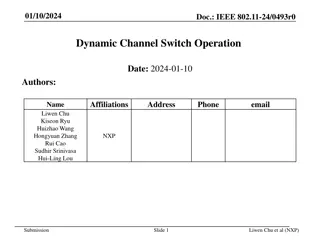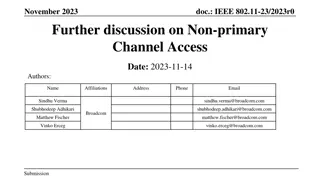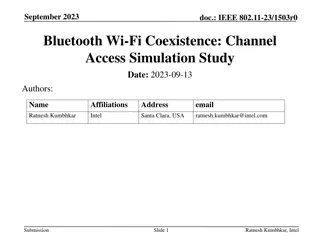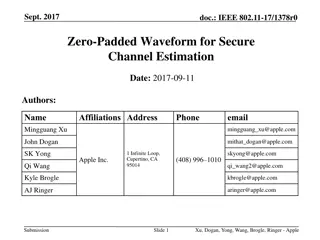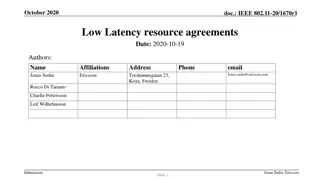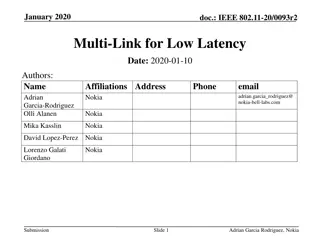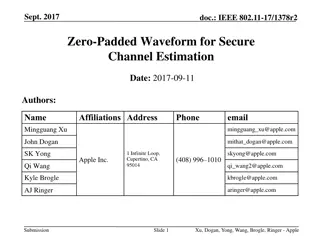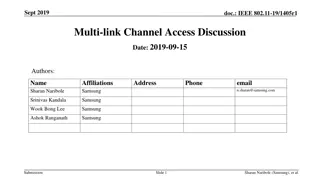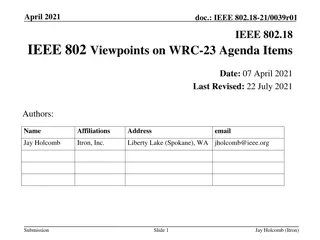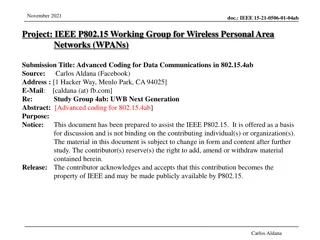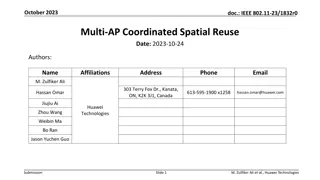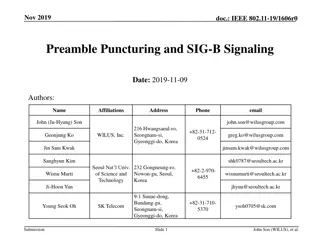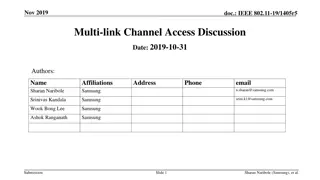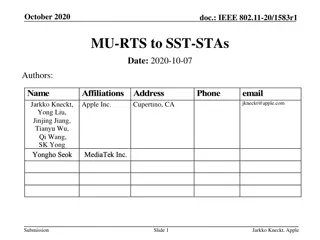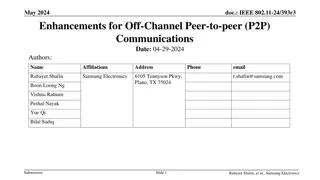Addressing Issues in Secondary Channel Access for IEEE 802.11-24 Networks
This submission for IEEE 802.11-24 discusses the potential issues and solutions related to secondary channel access (SCA) in UHR/11bn networks. The focus is on coordinating access points (APs) and stations (STAs) to optimize channel utilization without causing interference. The challenges include design complexities, transmission success probabilities, and synchronization issues between primary and secondary channels. The proposed solutions aim to improve overall network performance and efficiency.
Uploaded on Oct 08, 2024 | 0 Views
Download Presentation

Please find below an Image/Link to download the presentation.
The content on the website is provided AS IS for your information and personal use only. It may not be sold, licensed, or shared on other websites without obtaining consent from the author. Download presentation by click this link. If you encounter any issues during the download, it is possible that the publisher has removed the file from their server.
E N D
Presentation Transcript
doc.: IEEE 802.11-24/0318r0 March 2024 Robust secondary channel access Date: 2024-01-04 Authors: Name Affiliations Address Phone Email Yanchun Li Huawei Industrial Base, Bantian, Longgang District, Shenzhen 518129 China liyanchun@huawei.com Yunbo Li Hassan Omar Huawei Yanchun Li (Huawei) Submission Slide 1
doc.: IEEE 802.11-24/0318r0 March 2024 Introduction A number of UHR/11bn contributions have discussed non-primary channel access (NPCA), aka. Secondary channel access (SCA). This contribution discusses usage scenario of secondary channel access and potential issues. The finding is that coordination among APs and STAs can better address these issues. The proposed solution can utilized idle secondary channel without compromising complexity or cause interference. Yanchun Li (Huawei) Submission Slide 2
doc.: IEEE 802.11-24/0318r0 March 2024 Recap secondary channel access Due to limited BW capability at non-AP STA, or limited power budget, OBSS AP can reduce its transmitting BW to better serve its STA. The idle secondary channel (S40) can be used by AP1 to improve channel utilization. AP1 S40 AP1 s P80 AP1 s P80 OBSS AP2 s P40 Transmissions Yanchun Li (Huawei) Submission Slide 3
doc.: IEEE 802.11-24/0318r0 March 2024 Issue in Secondary channel access Secondary channel access has to be carefully designed. Otherwise, it will make trouble. AP1 S40 AP1 s P80 AP1 s P80 OBSS AP2 s P40 Transmissions S40 sensing P40 Tx P40 Tx X STA1 (hidden from AP2) AP1 AP2 Yanchun Li (Huawei) Submission Slide 4
doc.: IEEE 802.11-24/0318r0 March 2024 Issues in seconary channel access When lack of coordination, transmission success probability of a secondary channel access will be low. missed X S40 Tx P40 sensing P40 Tx STA1 (hidden from AP2) AP1 AP2 Yanchun Li (Huawei) Submission Slide 5
doc.: IEEE 802.11-24/0318r0 March 2024 Issues in secondary channel access Sync Issue 1: AP on the SCH while STA is still on PCH Sync Issue 2: AP on the SCH2 while STA is on SCH1, when more than one SCHs for Back-off Sync Issue 3: ED is not sufficient when PCH of OBSS is on this SCH Sync Issue 4: Multiple APs and non-AP STAs may content on SCH. Need a simple channel access rule on SCH Sync Issue 5: If Basic NAV on PCH is short, STA may prefer to stay on PCH for the sake of power saving. S40 Basic NAV on PCH P40 OBSS S40-2 PCH to SCH channel switch time Duration Rule/ Maximum number of TXOPs S40-1 S40-0 P40 Local BSS Tx Subtype of control frame S40 PCH=primary channel SCH=secondary channel P40 Local BSS Rx Yanchun Li (Huawei) Submission
doc.: IEEE 802.11-24/0318r0 March 2024 Proposed scheme Propose that AP1 use explicit frames to notify all STAs. So, the process is in more coordinated way. AP, as initiator, performs concurrent PD on secondary channels to better avoid interference on secondary channel, while STA can be simple and do single primary/secondary channel sensing. AP1 S40 AP1 s P80 AP1 s P80 OBSS AP2 s P40 Transmissions AP1 AP2 queries AP1 AP1 respond and indicate to switch to S40. It can prevent local hidden STA to contend on primary channel, also notify STA to go to secondary channel for SCA. S40 sensing and Rx P40 sensing P40 sensing STA1 Yanchun Li (Huawei) Submission
doc.: IEEE 802.11-24/0318r0 March 2024 Proposed scheme To simplify the implementation, AP1 s transmission on secondary channel and primary channel starts simultaneously. AP1 S40 AP1 s P80 AP1 s P80 OBSS AP2 s P40 Transmissions AP1 AP2 transmit PPDU to querie AP1 AP1 transmits PPDU to indicate switching to S40 and also announce NAV on secondary channel. Yanchun Li (Huawei) Submission
doc.: IEEE 802.11-24/0318r0 March 2024 Conclusions This presentation proposed an UHR secondary channel access process to improve channel utilization. It increases the robustness of access on secondary channel and resolves hidden node issue. Yanchun Li (Huawei) Submission Slide 9
doc.: IEEE 802.11-24/0318r0 March 2024 Reference [1] https://mentor.ieee.org/802.11/dcn/23/11-23-0797-01-0uhr-non-primary-channel-access.pptx [2] https://mentor.ieee.org/802.11/dcn/23/11-23-1288-00-0uhr-non-primary-channel-utilization-follow-up.pptx Yanchun Li (Huawei) Submission Slide 10
doc.: IEEE 802.11-24/0318r0 March 2024 Straw Poll 1 Do you agree that 11bn provides a secondary channel access mode to increase channel access efficiency? Yes No Abstain Yanchun Li (Huawei) Submission
doc.: IEEE 802.11-24/0318r0 March 2024 Straw Poll 2 Do you agree that 11bn provides a robust secondary channel access mode which allows AP to indicate secondary channel access to avoid hidden node issue? Yes No Abstain Yanchun Li (Huawei) Submission
